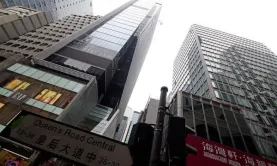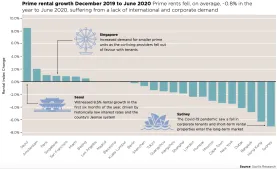In Focus
All you need to know about the biggest Malaysian property transactions in Q1
All you need to know about the biggest Malaysian property transactions in Q1
The total value of major transactions jumped 53% to approximately US$354m.
APAC cold storage facilities in hot demand amidst vaccine rollouts
Cold chain storage remains undersupplied in Asia on a per capita basis.
APAC markets show ‘unrelenting’ logistics demand as firms run short of warehouse space
ESR Australia recently bought a portfolio of 45 properties for a whopping US$2.9b.
These two APAC markets saw the highest surge in commercial property investments in Q1
Investments jumped 68% and 280% in Australia and Singapore, respectively.
How investors, landlords can unlock US$15.3b worth of value stuck in ageing properties
Half of the properties in APAC prime locations is over 20 years old.
Hong Kong office vacancy rate hits 15-year high as banks continue aggressive downsizing
Standard Chartered, DBS, Deutsche Bank and Societe Generale cut massive floor spaces.
APAC data centre net absorption hits record high in 2020
Total net absorption doubled in Tokyo, Sydney, Singapore and Hong Kong SAR, reaching 322 megawatts (MW).
Global residential prices growing at their fastest rate in three years
New Zealand posted the highest annual price growth in APAC at 19%.
APAC investment volume to rise by up to 20% this year
Thanks to growth in logistics, data centres, and multifamily investments.
Operators, investors on the lookout for distressed hotel assets in Japan
The distressed opportunities make great entry points into Japan’s promising hospitality market.
13 real estate themes to watch out for as Melbourne recovers post-pandemic
Stakeholders in Melbourne’s property markets have reason to be optimistic.
Why investors are going gaga over multifamily real estate
Investors spent US$116 billion on multifamily assets in the first nine months of 2020. Real estate investors are increasingly hunting for multifamily real estate, a sign of the broader pivot toward defensive strategies amid ongoing economic uncertainty. Investment in all real estate sectors fell 44 percent in the third quarter of the year, compared to the same period in 2019, according to JLL. However, multifamily has fared better than most other sectors, with investment falling, but by 27 percent. Investors picked up US$116 billion of multifamily assets in the first nine months of this year. Multifamily offers investors “a view through and beyond COVID-19”, says Gemma Kendall, head of multifamily investment, EMEA Capital Markets at JLL. "Housing demand remains high in many cities around the world and supply has struggled to keep up. As a result, investors are viewing multifamily opportunities as more resilient than other asset classes." Even at the height of the pandemic, and with the introduction of rent controls in many major cities, there has been little evidence that rents are going unpaid. A recent JLL survey of institutional owners of residential assets found that rent collection stood at 95 percent in the U.K., and at 94 percent in the U.S. In Europe, multifamily investment is up five percent year-to-date. In Asia Pacific, multifamily and build-to-rent investment topped US$7.4 billion in the first nine months of this year, up 83 percent year-on-year. Demographic shifts and institutional support are driving demand for Asia Pacific’s multifamily sector, explains Regina Lim, head of capital markets research, Asia Pacific, JLL. "Fundraising among global investors will further accelerate, with the focus being on both traditional markets like Japan and emerging renting markets like China, Australia and Korea." Japan’s multifamily market, the second largest in the world behind the U.S., is increasingly in the spotlight with investment almost tripling in the first half of this year. In August, German institution Allianz Real Estate invested $160 million in a portfolio of 18 Japanese multifamily assets for its core Asia-Pacific fund, while Blackstone paid US$3 billion in February to repurchase a portfolio of 200 apartments in Osaka and Tokyo from Chinese insurer Anbang. Partnering up While COVID-19 has accelerated investment, the multifamily sector was already attracting global private equity, investment managers, insurers and sovereign wealth funds. In the past decade, multifamily deals as a proportion of global real estate investment have roughly doubled to 25 percent. As it became more mainstream, it started appealing to a broader range of investors. In the U.S., AIMCO this year agreed a 10-year joint venture with a passive institutional investor for a US$2.4 billion portfolio in California. AXA IM Real Assets recently completed a major transaction, buying Dolphin Square, in London. The growth of experienced players is essential if the market is to evolve sufficiently to meet increasing demand, with partnerships becoming a popular choice, says Kendall. "We’ve seen investors employ such strategies to find the expertise that they require in new geographies,” says Kendall. “It’s also a relatively granular sector; portfolio aggregation has been a strategy adopted by many but growing organically takes time." For several institutional groups, the best way to enter the market has been to team up with players who can develop, source transactions and partner on the operational side. Nuveen Real Estate recently joined forces with Iberian investment manager Kronos to develop a €1 billion build-to-rent portfolio of 5,000 homes in Spain.
Top 3 real estate sectors that have piqued investors' interest for 2021
Investors expect to increase their exposure to logistics, living investment, and alternative asset classes.
Sydney rents worst hit by COVID, whilst Seoul and Moscow prices rose most: Savills
The Savills Prime Index: World Cities report shows just how much has changed in property since COVID hit.
Indonesia's hospitals brace for disruption in healthtech and consumer behaviour
Traditional business models are being broken due to changes caused by healthtech and moves towards universal healthcare.
















 Advertise
Advertise









